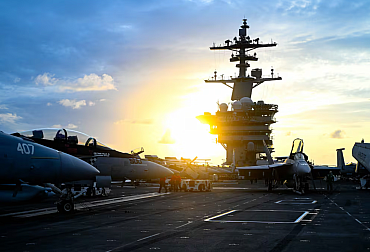USS Theodore Roosevelt arrives in South Korea amid heightened tensions with North Korea
In a significant display of military might and unity, the nuclear-powered U.S. aircraft carrier USS Theodore Roosevelt arrived in Busan, South Korea, on Saturday. This deployment is part of a three-way exercise involving South Korea and Japan, aimed at enhancing military readiness in response to escalating threats from North Korea.

Strategic timing and international reactions
The arrival of the USS Theodore Roosevelt strike group is particularly notable given the recent geopolitical developments in the region. Just a day before, South Korea summoned the Russian ambassador to express its discontent over a new security pact between Russian President Vladimir Putin and North Korean leader Kim Jong Un. The agreement, which pledges mutual defense assistance in the event of war, has been perceived by South Korea as a direct threat to its national security.
In retaliation, South Korea has hinted at the possibility of sending arms to Ukraine to aid in its defense against the Russian invasion. Such a move would undoubtedly strain relations between Seoul and Moscow, illustrating the complex and interconnected nature of international alliances and conflicts.
Freedom edge drills: Enhancing tactical proficiency and interoperability
The Roosevelt strike group's visit is part of the Freedom Edge drills, a series of exercises announced following a meeting between the defense chiefs of the United States, South Korea, and Japan in Singapore earlier in June. Rear Admiral Christopher Alexander, commander of Carrier Strike Group Nine, emphasized the importance of these drills in sharpening the tactical proficiency of participating ships and enhancing interoperability among the navies of the three nations. He stated that the exercises are designed to ensure readiness to respond to any crisis or contingency.
Although South Korea's military has yet to disclose specific details of the training, the overarching goal is clear: to present a united front and demonstrate a robust defense posture in the face of advancing North Korean threats. The South Korean navy highlighted that the carrier's arrival underscores the strong defense alliance between the countries and their stern willingness to counter any aggressive moves from the North.
Historical context and regional implications
This deployment follows the visit of another U.S. aircraft carrier, the USS Carl Vinson, to South Korea seven months prior, signaling a continued commitment by the United States to its allies in the region. The Roosevelt strike group's involvement in a similar three-way exercise in the disputed East China Sea in April further underscores the strategic importance of these joint operations. These exercises not only address North Korean provocations but also respond to growing concerns over China's territorial ambitions.
Broader strategic objectives
Following the completion of the Freedom Edge drills, the Roosevelt strike group is set to proceed to the Middle East. According to Pentagon spokesperson Maj. Gen. Pat Ryder, the group will focus on promoting regional stability, deterring aggression, and ensuring the free flow of commerce. This highlights the multi-faceted role of U.S. naval forces in maintaining global security and protecting international trade routes.
Strengthening nuclear deterrence and regional defense
In light of the persistent threats from North Korea, the United States, South Korea, and Japan have not only expanded their combined training but also increased the visibility of strategic U.S. military assets in the region. This is part of a broader effort to intimidate North Korea and dissuade it from pursuing aggressive actions.
Furthermore, the United States and South Korea have been actively updating their nuclear deterrence strategies. Seoul has sought stronger assurances from Washington regarding the swift and decisive use of its nuclear capabilities in the event of a North Korean nuclear attack. This reflects a growing urgency to bolster defense mechanisms and ensure a credible deterrent against potential threats.
Conclusion
The arrival of the USS Theodore Roosevelt in South Korea represents a significant milestone in the ongoing efforts to counter North Korean provocations and maintain stability in the region. As the United States, South Korea, and Japan continue to enhance their military cooperation and strategic preparedness, the message to Pyongyang is clear: the allies are united and ready to respond to any threat with strength and resolve.








